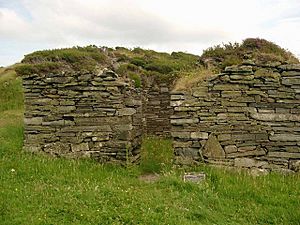Eileach an Naoimh facts for kids
| Gaelic name | Eileach an Naoimh |
|---|---|
| Meaning of name | rocky place of the saint |
| OS grid reference | NM641098 |
| Coordinates | 56°13′21″N 5°48′22″W / 56.2225°N 5.8060°W |
| Physical geography | |
| Island group | Garvellachs |
| Area | 56 ha (138 acres) |
| Area rank | 188 |
| Highest elevation | 80 m (262 ft) |
| Administration | |
| Sovereign state | United Kingdom |
| Country | Scotland |
| Council area | Argyll and Bute |
| Demographics | |
| Population | 0 |
Eileach an Naoimh, also called Holy Isle, is a small island off the west coast of Scotland. No one lives on this island today. It's part of a group of islands called the Garvellachs and is the one furthest south. You can find it in the Firth of Lorne, a sea area between the larger islands of Mull and Argyll. The name Eileach an Naoimh comes from Gaelic and means "rocky place of the saint".
Contents
History of Eileach an Naoimh
This small island has a very old and interesting history. Around the year 542, a famous saint named St. Brendan the Navigator is thought to have started a monastery here. A monastery is a place where monks live and pray. He might have chosen this island because it was very isolated and had good land for animals to graze.
Another well-known saint, Columba, is also believed to have visited Eileach an Naoimh. Some people even think this island might be the mysterious place called Hinba, where Saint Columba went for quiet retreats. It's also possible that Saint Columba's mother, Eithne, was buried on Eileach an Naoimh.
Viking Raids and Island Life
Around the year 800, the monastery on Eileach an Naoimh faced danger from Viking raiders. These raids made the island a very unsafe place. Because of this, the monastery was either destroyed or became too risky to live in.
After the Vikings, people probably only lived on the island now and then. This lack of constant living has actually helped to preserve the old buildings. Many of the original monastery ruins are still standing today.
Exploring the Ancient Ruins
When you visit Eileach an Naoimh, you can see the remains of many old buildings. These include:
- Two chapels (small churches)
- Beehive cells, which are small, round stone huts where monks might have lived
- A graveyard with three stone crosses
- Another circular grave
The beehive cells are located inside a special five-sided (pentagonal) stone wall. This wall looks out over a rocky spot where boats would land on the south side of the island. This landing spot was protected by several small rocky islands called skerries. Outside this walled area, there's another cell with two rooms.
The oldest chapel on the island is shaped like a rectangle. Experts believe it might have been built between the 11th and 12th centuries. These monastic ruins are some of the oldest church buildings in all of Scotland. They are looked after by Historic Environment Scotland, an organization that protects important historical sites. If these ruins truly date back to Saint Brendan's time, they could be the oldest church buildings still standing in Britain! However, the first written record mentioning them is from the late 9th century.
Visiting Eileach an Naoimh
There isn't a regular boat service to Eileach an Naoimh. If you want to visit this historic island or its neighbors, you need to arrange your own private transport.
See also
 In Spanish: Eileach an Naoimh para niños
In Spanish: Eileach an Naoimh para niños


